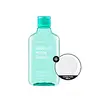What's inside
What's inside
 Key Ingredients
Key Ingredients

 Benefits
Benefits

 Concerns
Concerns

 Ingredients Side-by-side
Ingredients Side-by-side

Water
Skin ConditioningChrysanthemum Indicum Extract
AntioxidantButylene Glycol
HumectantSalvia Officinalis Extract
Antimicrobial1,2-Hexanediol
Skin ConditioningCitrus Limon Leaf Extract
PerfumingBeta Vulgaris Root Extract
Skin ConditioningNiacinamide
SmoothingGlycereth-25 PCA Isostearate
EmulsifyingMenthol
MaskingCitrus Depressa Fruit Extract
Skin ConditioningViscum Album Extract
Skin ConditioningMenthyl Lactate
MaskingCapsicum Annuum Fruit Extract
AntimicrobialOak Root Extract
Skin ConditioningSalix Alba Bark Extract
AstringentAmmonium Acryloyldimethyltaurate/Vp Copolymer
Xanthan Gum
EmulsifyingEthylhexylglycerin
Skin ConditioningCaprylyl Glycol
EmollientHydroxyacetophenone
AntioxidantAlcohol Denat.
AntimicrobialGlycerin
HumectantBetaine
HumectantCentella Asiatica Extract
CleansingRosmarinus Officinalis Leaf Oil
MaskingTriticum Vulgare Germ Extract
Skin ConditioningMelaleuca Alternifolia Leaf Extract
PerfumingCopper Tripeptide-1
Skin ConditioningPalmitoyl Pentapeptide-4
Skin ConditioningAcetyl Hexapeptide-8
HumectantPalmitoyl Tripeptide-1
Skin ConditioningPalmitoyl Tetrapeptide-7
Skin ConditioningAllantoin
Skin ConditioningSodium Hyaluronate
HumectantAdenosine
Skin ConditioningDisodium EDTA
Water, Chrysanthemum Indicum Extract, Butylene Glycol, Salvia Officinalis Extract, 1,2-Hexanediol, Citrus Limon Leaf Extract, Beta Vulgaris Root Extract, Niacinamide, Glycereth-25 PCA Isostearate, Menthol, Citrus Depressa Fruit Extract, Viscum Album Extract, Menthyl Lactate, Capsicum Annuum Fruit Extract, Oak Root Extract, Salix Alba Bark Extract, Ammonium Acryloyldimethyltaurate/Vp Copolymer, Xanthan Gum, Ethylhexylglycerin, Caprylyl Glycol, Hydroxyacetophenone, Alcohol Denat., Glycerin, Betaine, Centella Asiatica Extract, Rosmarinus Officinalis Leaf Oil, Triticum Vulgare Germ Extract, Melaleuca Alternifolia Leaf Extract, Copper Tripeptide-1, Palmitoyl Pentapeptide-4, Acetyl Hexapeptide-8, Palmitoyl Tripeptide-1, Palmitoyl Tetrapeptide-7, Allantoin, Sodium Hyaluronate, Adenosine, Disodium EDTA
Water
Skin Conditioning1,2-Hexanediol
Skin ConditioningHamamelis Virginiana Water
AstringentSalvia Officinalis Leaf Extract
CleansingButylene Glycol
HumectantArctium Majus Root Extract
Skin ConditioningChamaecyparis Obtusa Water
MaskingEucalyptus Globulus Leaf Extract
PerfumingMelissa Officinalis Leaf Extract
Skin ConditioningGlycerin
HumectantHypericum Perforatum Flower/Leaf/Stem Extract
Skin ConditioningSaponaria Officinalis Leaf Extract
AntimicrobialSorbitol
HumectantGluconolactone
Skin ConditioningEthylhexylglycerin
Skin ConditioningPropanediol
SolventTrisodium Ethylenediamine Disuccinate
4-Terpineol
MaskingSuccinic Acid
BufferingBetaine
HumectantMelaleuca Alternifolia Leaf Water
AntimicrobialPanthenol
Skin ConditioningHyaluronic Acid
HumectantHydrolyzed Hyaluronic Acid
HumectantSodium Hyaluronate
HumectantPunica Granatum Flower Extract
Skin ConditioningPentylene Glycol
Skin ConditioningCaprylyl Glycol
EmollientWater, 1,2-Hexanediol, Hamamelis Virginiana Water, Salvia Officinalis Leaf Extract, Butylene Glycol, Arctium Majus Root Extract, Chamaecyparis Obtusa Water, Eucalyptus Globulus Leaf Extract, Melissa Officinalis Leaf Extract, Glycerin, Hypericum Perforatum Flower/Leaf/Stem Extract, Saponaria Officinalis Leaf Extract, Sorbitol, Gluconolactone, Ethylhexylglycerin, Propanediol, Trisodium Ethylenediamine Disuccinate, 4-Terpineol, Succinic Acid, Betaine, Melaleuca Alternifolia Leaf Water, Panthenol, Hyaluronic Acid, Hydrolyzed Hyaluronic Acid, Sodium Hyaluronate, Punica Granatum Flower Extract, Pentylene Glycol, Caprylyl Glycol
 Reviews
Reviews

Ingredients Explained
These ingredients are found in both products.
Ingredients higher up in an ingredient list are typically present in a larger amount.
1,2-Hexanediol is a synthetic liquid and another multi-functional powerhouse.
It is a:
- Humectant, drawing moisture into the skin
- Emollient, helping to soften skin
- Solvent, dispersing and stabilizing formulas
- Preservative booster, enhancing the antimicrobial activity of other preservatives
Betaine is a common humectant (a substance that promotes retention of moisture). It's known to be gentle on the skin and can help balance hydration.
This ingredient is best for improving hydration and soothing irritated skin. Studies also show it helps even out skin tone.
Fun fact: Betaine is naturally created in the skin and body. The kind found within cosmetic products can be either plant-derived or synthetic.
Another name for betaine is trimethylglycine.
Learn more about BetaineButylene Glycol (or BG) is used within cosmetic products for a few different reasons:
Overall, Butylene Glycol is a safe and well-rounded ingredient that works well with other ingredients.
Though this ingredient works well with most skin types, some people with sensitive skin may experience a reaction such as allergic rashes, closed comedones, or itchiness.
Learn more about Butylene GlycolCaprylyl Glycol is a humectant and emollient, meaning it attracts and preserves moisture.
It is a common ingredient in many products, especially those designed to hydrate skin. The primary benefits are retaining moisture, skin softening, and promoting a healthy skin barrier.
Though Caprylyl Glycol is an alcohol derived from fatty acids, it is not the kind that can dry out skin.
This ingredient is also used as a preservative to extend the life of products. It has slight antimicrobial properties.
Learn more about Caprylyl GlycolEthylhexylglycerin (we can't pronounce this either) is commonly used as a preservative and skin softener. It is derived from glyceryl.
You might see Ethylhexylglycerin often paired with other preservatives such as phenoxyethanol. Ethylhexylglycerin has been found to increase the effectiveness of these other preservatives.
Glycerin is already naturally found in your skin. It helps moisturize and protect your skin.
A study from 2016 found glycerin to be more effective as a humectant than AHAs and hyaluronic acid.
As a humectant, it helps the skin stay hydrated by pulling moisture to your skin. The low molecular weight of glycerin allows it to pull moisture into the deeper layers of your skin.
Hydrated skin improves your skin barrier; Your skin barrier helps protect against irritants and bacteria.
Glycerin has also been found to have antimicrobial and antiviral properties. Due to these properties, glycerin is often used in wound and burn treatments.
In cosmetics, glycerin is usually derived from plants such as soybean or palm. However, it can also be sourced from animals, such as tallow or animal fat.
This ingredient is organic, colorless, odorless, and non-toxic.
Glycerin is the name for this ingredient in American English. British English uses Glycerol/Glycerine.
Learn more about GlycerinSodium Hyaluronate is hyaluronic acid's salt form. It is commonly derived from the sodium salt of hyaluronic acid.
Like hyaluronic acid, it is great at holding water and acts as a humectant. This makes it a great skin hydrating ingredient.
Sodium Hyaluronate is naturally occurring in our bodies and is mostly found in eye fluid and joints.
These are some other common types of Hyaluronic Acid:
Learn more about Sodium HyaluronateWater. It's the most common cosmetic ingredient of all. You'll usually see it at the top of ingredient lists, meaning that it makes up the largest part of the product.
So why is it so popular? Water most often acts as a solvent - this means that it helps dissolve other ingredients into the formulation.
You'll also recognize water as that liquid we all need to stay alive. If you see this, drink a glass of water. Stay hydrated!
Learn more about Water